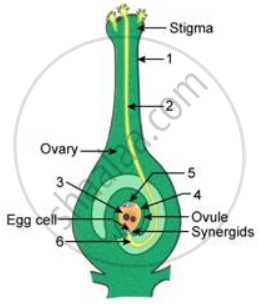Advertisements
Advertisements
Question
Explain the development of a Dicot embryo
Solution
The development of the Dicot embryo (Capsella bursa-pastoris) is of Onagrad or crucifer type. The embryo develops at the micropylar end of the embryo sac. The Zygote divides by a transverse division forming upper or terminal cell and lower or basal cell. The basal cell divides transversely and the terminal cell divides vertically to form a four celled proembryo. A second vertical division right angle to the first one takes place in the terminal cell forming a four celled stage called a quadrant. A transverse division in the quadrant results in eight cells arranged in two tiers of four each called the octant stage. The upper tier of four cells of the octant is called epibasal or anterior octant and the lower tier of four cells constitutes hypobasal or posterior octants. A periclinal division in the octants results in the formation of 16 celled stages with eight cells in the outer and eight in the inner. The outer eight cells represent the dermatogen and undergo anticlinal division to produce epidermis. The inner eight cells divide by vertical and transverse division to form the outer layer of the periblem which give rise to the cortex and a central region of pleurome which forms stele.
APPEARS IN
RELATED QUESTIONS
Double fertilization is reported in plants of both, castor and groundnut. However, the mature seeds of groundnut are non-albuminous and castor are albuminous. Explain the post fertilization events that are responsible for it.
(a) Explain the events after pollination leading to the formation of a seed in angiosperms.
(b) Mention the ploidy levels of the cells of different parts of an albuminous seed.
Match the items in Column A with those in Column B.
|
Column A |
Column B |
|
(a) Generative nucleus |
(i) Pollen tube |
|
(b) Germ pore |
(ii) Endosperm nucleus |
|
(c) Exine |
(iii) Testa |
|
(d) Secondary nucleus |
(iv) Fertilization |
|
(e) Integument |
(v) Male nuclei |
|
(f) Egg nucleus |
(vi) Rough |
Given ahead is a diagrammatic representation of the process of fertilization. Study the same and then answer the question that follows:

What happens to
i) Ovary
ii) Ovule after fertilisation
What is a fruit?
Syngamy results in the formation of ______.
Which of the following happens during triple fusion?
The success of seed plants on land is mainly due to ______.
By which of the following double fertilization is exhibited?
If the cells of the nucellus in the angiosperm ovule contain 24 chromosomes, then ____________ chromosomes will be present in the endosperm of a self-pollinated flower.
